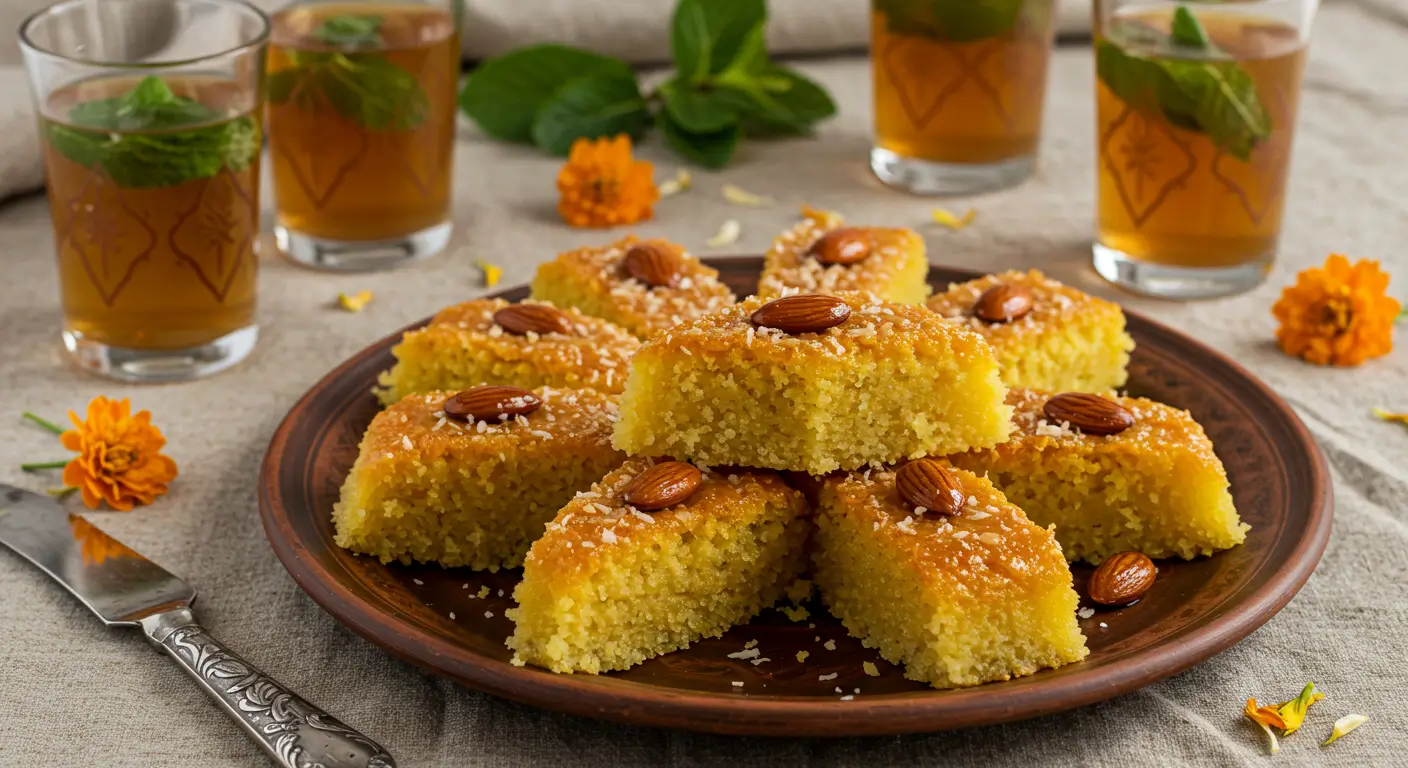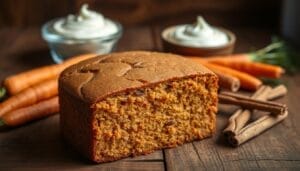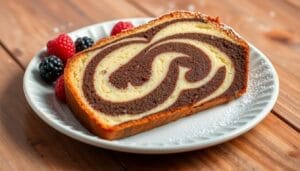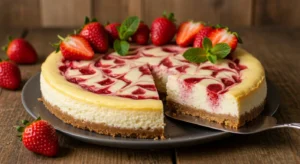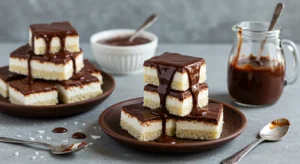Table of Contents
What if the most comforting dessert in the world could be made with just a handful of simple ingredients and still taste like it came from a Middle Eastern palace kitchen? This heavenly Moroccan Basbousa is a golden, syrup-soaked cake that melts in your mouth while delivering waves of sweet, nutty flavors that have been bringing families together around North African tables for centuries. Get ready to discover how this incredibly easy recipe transforms basic pantry staples into an exotic dessert that will make you feel like you’ve been transported to the bustling souks of Marrakech!
What Makes This Moroccan Basbousa So Special?
Moroccan Basbousa is pure comfort food in dessert form – a moist, tender cake made with semolina that soaks up fragrant syrup like a sweet sponge. Unlike regular cakes, basbousa has a unique texture that’s both tender and slightly grainy from the semolina, creating an incredibly satisfying eating experience.
Time Requirement: Just 1 hour total (20 minutes prep, 35 minutes baking, plus cooling time)
Difficulty Level: Super easy! This is one of the most forgiving desserts you’ll ever make. Even beginners can create perfect results with this simple mix-and-bake recipe.
What makes this recipe truly special is how it transforms humble ingredients into something magical. The semolina gives the cake its characteristic texture, while the syrup – scented with orange blossom water or rose water – turns each bite into a fragrant, sweet experience. This isn’t just dessert; it’s a celebration of Moroccan hospitality and tradition.
The cake is naturally dairy-free when made with vegetable oil, and it actually gets better as it sits and absorbs more syrup. It’s the perfect make-ahead dessert that feeds a crowd and keeps everyone happy.
Essential Ingredients for Perfect Moroccan Basbousa
Let’s explore what makes this Moroccan Basbousa absolutely irresistible:
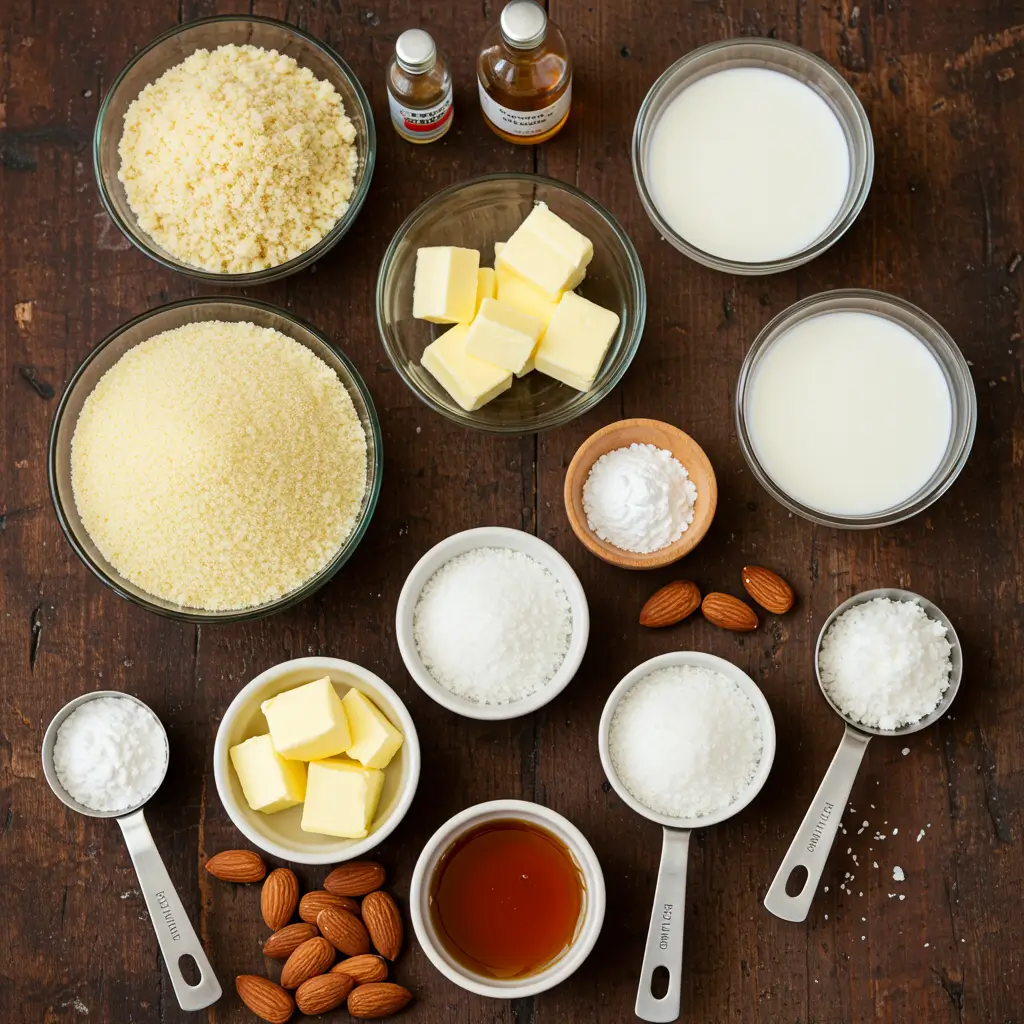
Fine Semolina (1.5 cups): This is the star ingredient! Semolina is made from durum wheat and gives basbousa its unique texture. Use fine semolina, not coarse, for the best results. Don’t substitute with regular flour – it won’t be authentic basbousa.
Granulated Sugar (3/4 cup): Sweetens the cake base. The sugar also helps create the tender crumb and golden color when baked.
Plain Greek Yogurt (1/2 cup): Adds moisture and tanginess that balances the sweetness. It also helps create the tender texture. You can use regular plain yogurt too.
Vegetable Oil (1/3 cup): Keeps the cake moist and makes it dairy-free. You can substitute with melted butter if you prefer.
Eggs (2 large): Bind everything together and add richness. Room temperature eggs mix better with the other ingredients.
Baking Powder (1.5 teaspoons): Gives the cake its rise and fluffy texture.
Vanilla Extract (1 teaspoon): Enhances all the other flavors.
Salt (1/4 teaspoon): Balances the sweetness and makes all flavors pop.
Blanched Almonds (1/4 cup, sliced): Traditional topping that adds crunch and visual appeal.
For the Syrup: Sugar (1 cup): Creates the sweet syrup base.
Water (1 cup): Dilutes the sugar to the right consistency.
Lemon Juice (2 tablespoons): Prevents crystallization and adds brightness.
Orange Blossom Water (2 teaspoons): The authentic Moroccan touch! This floral water is what makes it special.
Substitutions and Variations:
- No semolina? Look in Middle Eastern stores or order online – it’s worth the search!
- Dairy-free? Use coconut yogurt instead of Greek yogurt
- No orange blossom water? Rose water works beautifully, or use vanilla extract
- Want it richer? Add shredded coconut to the batter
- Nut allergies? Skip the almonds or use seeds instead
Step-by-Step Instructions: Creating Sweet Magic
Making this delicious Moroccan Basbousa is wonderfully straightforward. Here’s how to get perfect results:
Step 1: Prepare Your Pan and Oven (5 minutes)
Preheat your oven to 400°F (200°C). This high temperature helps create the golden top that makes basbousa so appealing.
Grease a 9×13 inch baking pan with oil or butter. You can also use a round 10-inch cake pan if you prefer.
Line the bottom with parchment paper for easy removal, though this step is optional.
Arrange the sliced almonds in a decorative pattern on the bottom of the pan. When you flip the cake later, these will be on top!
Pro tip: If you want the almonds on top without flipping, just sprinkle them over the batter before baking.
Step 2: Mix Your Batter (10 minutes)
In a large bowl, whisk together the semolina, sugar, baking powder, and salt. Make sure there are no lumps in the semolina.
In a separate bowl, whisk together the yogurt, oil, eggs, and vanilla until smooth and well combined.
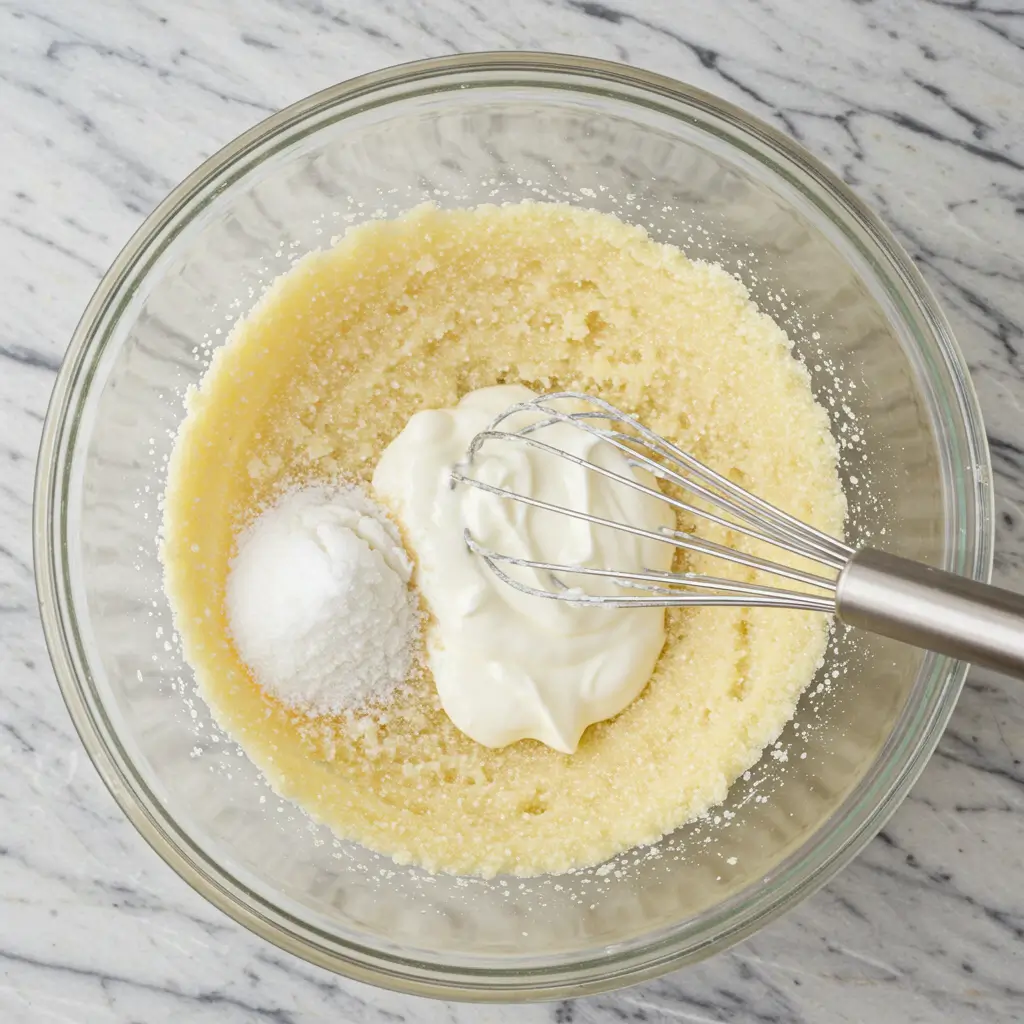
Pour the wet ingredients into the dry ingredients and stir until just combined. Don’t overmix – a few lumps are okay.
The batter should be thick but pourable. If it seems too thick, add a tablespoon of milk or water.
Let the batter rest for 5 minutes. This allows the semolina to absorb the liquids and creates a better texture.
Mixing tip: The batter will look different from regular cake batter – it’s more like thick porridge. This is exactly what you want!
Step 3: Bake to Golden Perfection (35 minutes)
Pour the batter over the almonds in your prepared pan. Spread it evenly with a spatula.
Bake for 30-35 minutes, until the top is golden brown and a toothpick inserted in the center comes out with just a few moist crumbs.
While the cake bakes, make your syrup. In a small saucepan, combine sugar, water, and lemon juice. Bring to a boil, then reduce heat and simmer for 10 minutes until slightly thickened.
Remove from heat and stir in the orange blossom water. Let the syrup cool slightly while the cake finishes baking.
Baking tip: The cake should be golden on top and pulling slightly from the edges when done. Don’t overbake or it will be dry.
Building Your Basbousa Base: Expert Techniques
The secret to amazing Moroccan Basbousa lies in getting these details right:
Semolina Quality: Use fine semolina, not coarse. The finer texture creates a more tender cake that absorbs syrup better.
Syrup Temperature: The syrup should be warm (not hot) when you pour it over the hot cake. This creates the best absorption.
Soaking Time: Let the cake absorb the syrup for at least 2 hours before serving. Patience is key for perfect basbousa!
Cutting Technique: Use a sharp knife and cut all the way through to the bottom. Clean the knife between cuts for neat squares.
Presentation Tips:
- Cut into diamond shapes for traditional presentation
- Garnish each piece with a whole almond or pistachio
- Dust lightly with powdered sugar before serving
- Serve on colorful plates to highlight the golden color
- Add a dollop of whipped cream or ice cream for extra indulgence
- Drizzle with extra syrup just before serving
Texture Notes: Perfect basbousa should be moist and tender, not soggy. The syrup should be absorbed, not sitting on top.
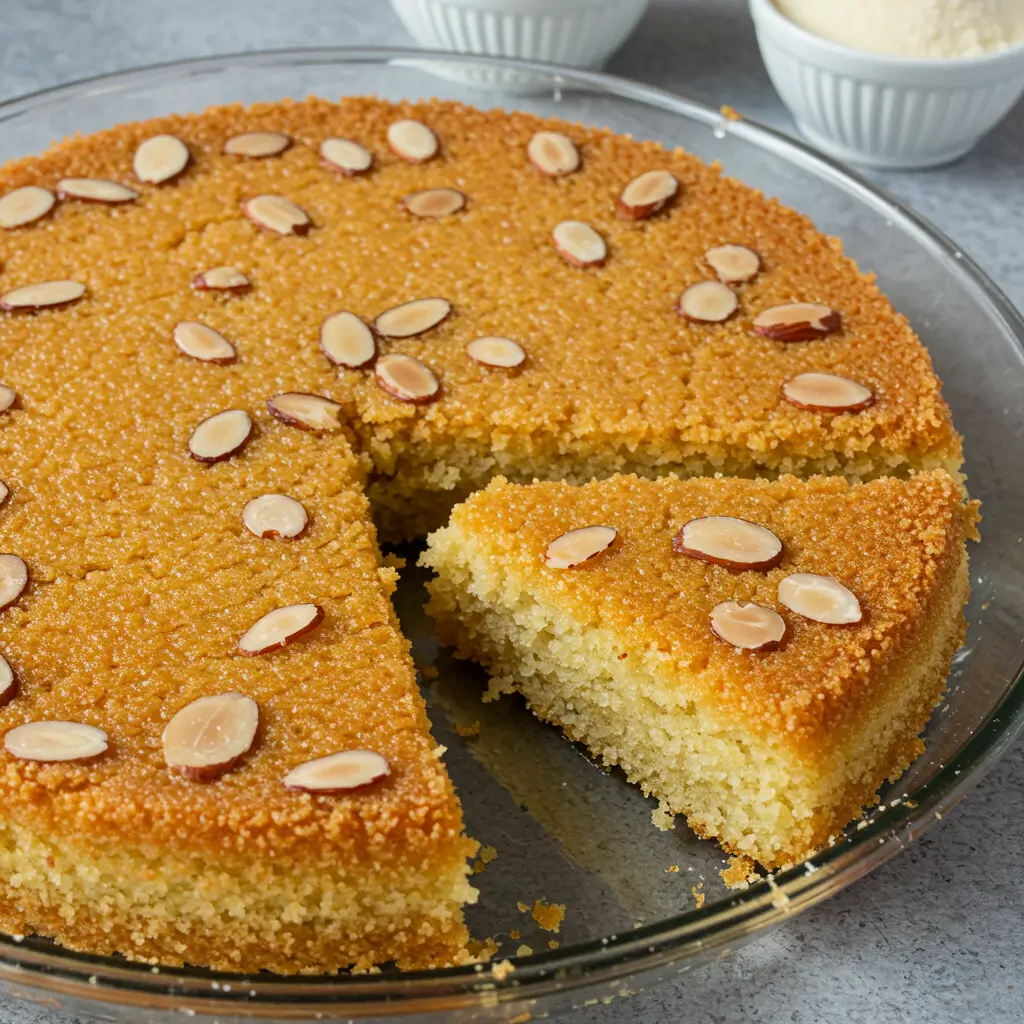
Storage and Make-Ahead Tips
This Moroccan Basbousa actually improves with time! Here’s how to handle storage:
Room Temperature: Store covered at room temperature for up to 4 days. The flavors develop and improve over time.
Refrigerated: Keeps in the fridge for up to one week. Bring to room temperature before serving for the best flavor.
Make-Ahead Tips:
- Make the entire cake up to 3 days in advance – it gets even better!
- Prepare the syrup up to one week ahead and refrigerate
- Mix dry ingredients in advance and store in an airtight container
- This cake is perfect for entertaining because it must be made ahead
Serving Temperature: Basbousa is traditionally served at room temperature, which allows all the flavors to shine through.
Freezing: You can freeze basbousa for up to 2 months. Wrap individual pieces in plastic wrap and thaw at room temperature.
Creative Recipe Variations
Once you master traditional Moroccan Basbousa, try these delicious twists:
Coconut Basbousa: Add 1/2 cup shredded coconut to the batter and top with toasted coconut flakes for tropical flavor.
Chocolate Chip Version: Fold in 1/2 cup mini chocolate chips for a modern twist that kids will love.
Rose Water Basbousa: Replace orange blossom water with rose water for a different floral note that’s equally authentic.
Pistachio Topped: Replace almonds with chopped pistachios for beautiful green color and rich flavor.
Lemon Basbousa: Add lemon zest to the batter and lemon juice to the syrup for bright, citrusy flavor.
Mini Individual Cakes: Bake in muffin tins for 20-25 minutes for perfect portion control and gift-giving.
Cream Cheese Swirl: Drop spoonfuls of sweetened cream cheese on top and swirl before baking.
Date and Walnut: Add chopped dates and walnuts to the batter for extra texture and traditional flavors.
Orange Zest Version: Add orange zest to both the cake and syrup for intense citrus flavor.
Conclusion: Your New Favorite Comfort Dessert
This Moroccan Basbousa is more than just a recipe – it’s your gateway to the warm, welcoming world of North African desserts. With its incredibly simple preparation and absolutely divine results, this cake proves that the best comfort foods often come from the most humble ingredients.
The beauty of basbousa lies in its forgiving nature and make-ahead convenience. Unlike many desserts that must be served immediately, this one actually improves as it sits and absorbs that fragrant syrup. It’s the perfect dessert for busy hosts who want to impress without stress.
The unique texture of semolina combined with the floral sweetness of orange blossom water creates an eating experience that’s both exotic and comforting. Each bite transports you to sun-drenched courtyards and spice-scented markets, yet it’s simple enough to become a regular in your dessert rotation.
Don’t be intimidated by ingredients like semolina or orange blossom water – they’re easier to find than you think, and once you taste the difference they make, you’ll understand why they’re essential. This cake is also incredibly versatile, welcoming variations and personal touches while maintaining its authentic character.
Whether you’re looking for a special dessert for entertaining, a comforting treat for your family, or a way to explore new flavors, this Moroccan Basbousa delivers on every level. It’s sweet without being cloying, exotic without being intimidating, and impressive without being difficult.
So gather your semolina, find some orange blossom water, and treat yourself to this magical dessert. Once you taste homemade basbousa, you’ll understand why it’s been a beloved treat across the Middle East and North Africa for generations. Happy baking, and enjoy every syrup-soaked, perfectly sweet bite!
Did you love it ? Let us know!
There are no reviews yet. Be the first one to write one.

